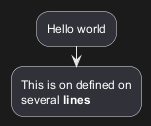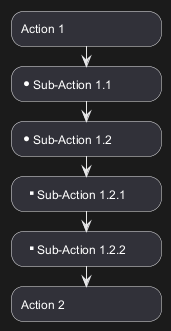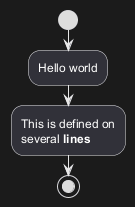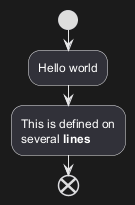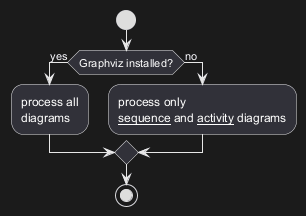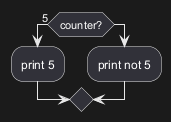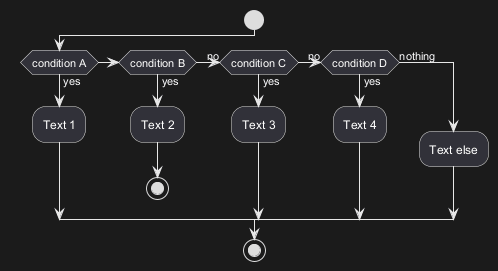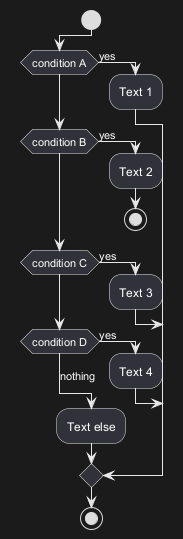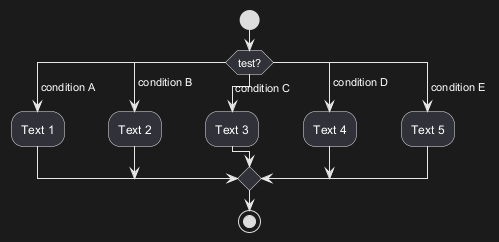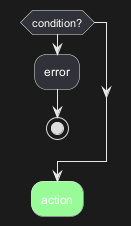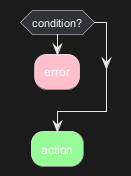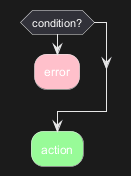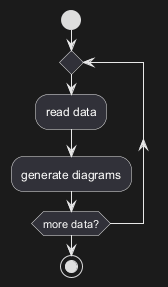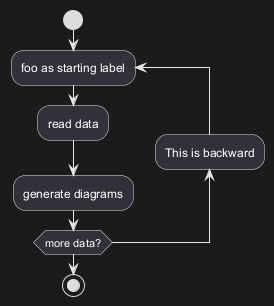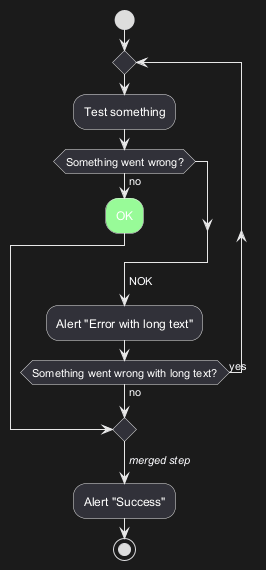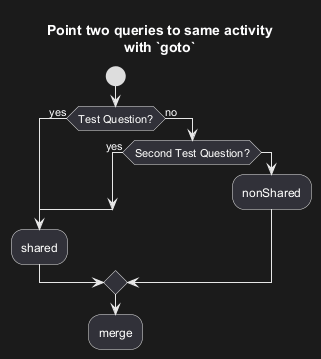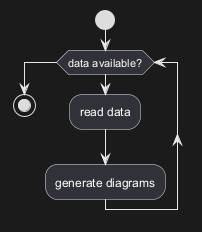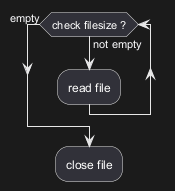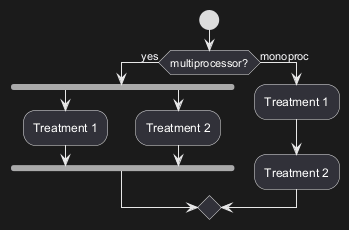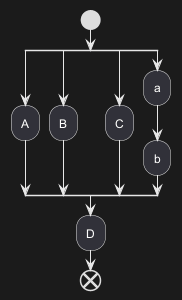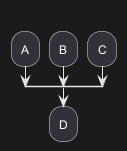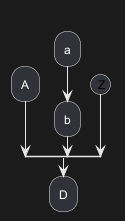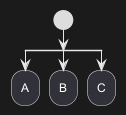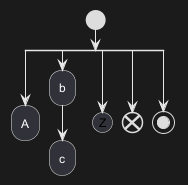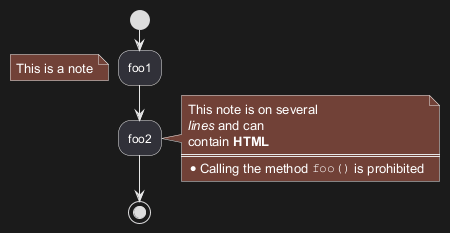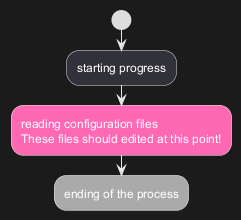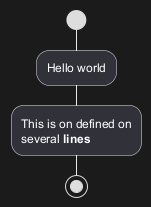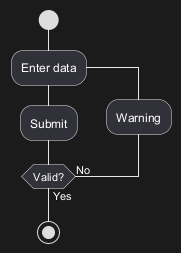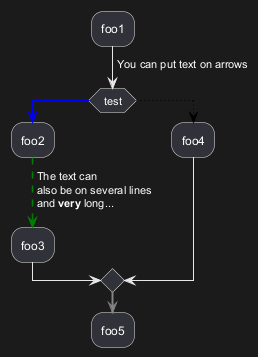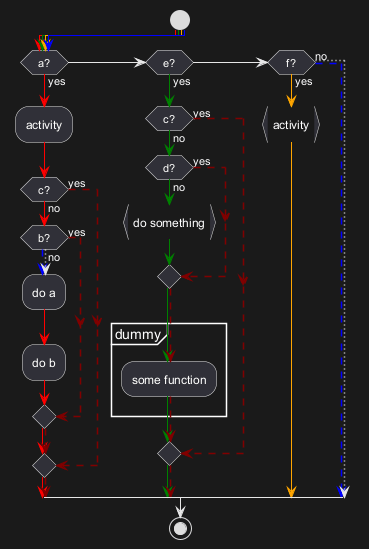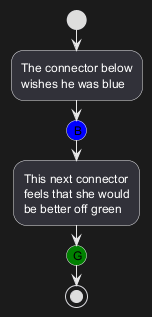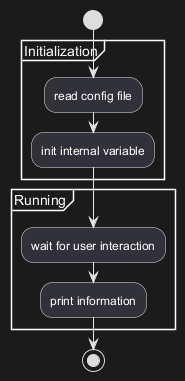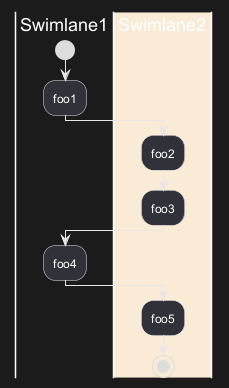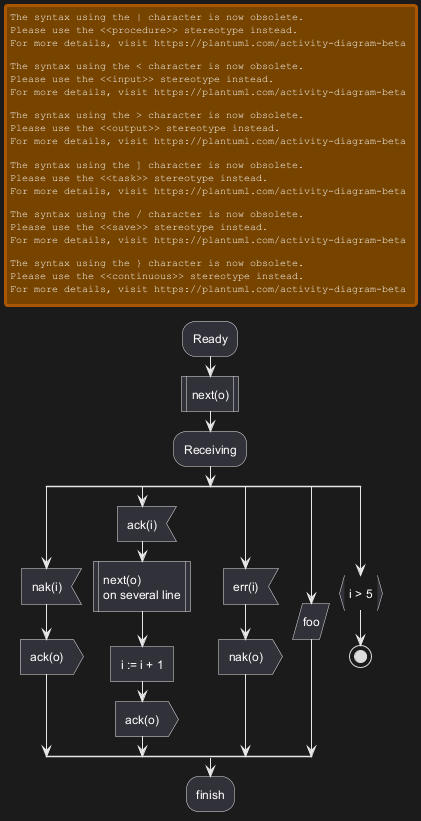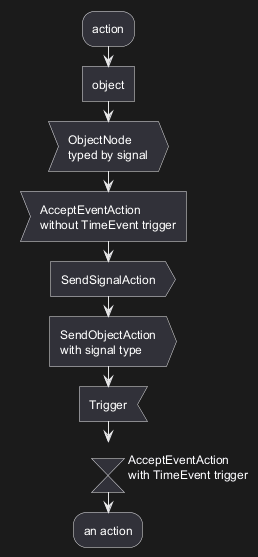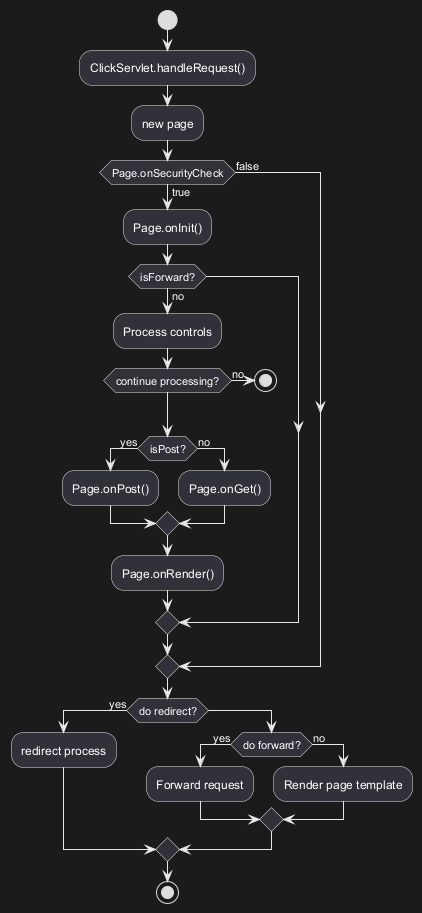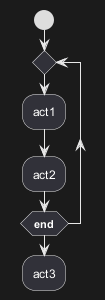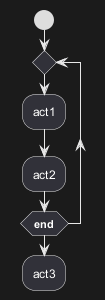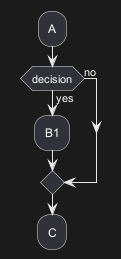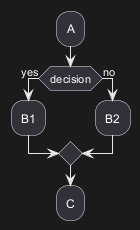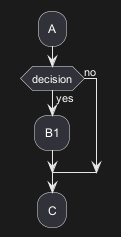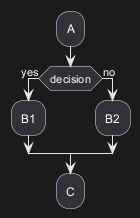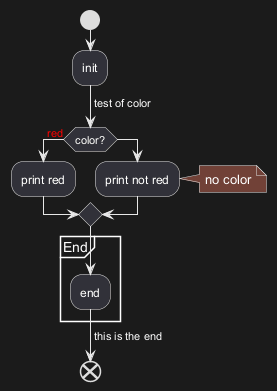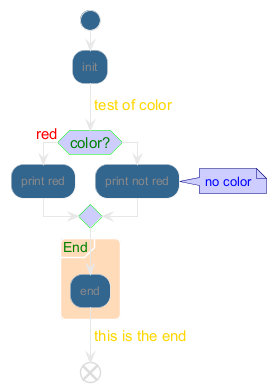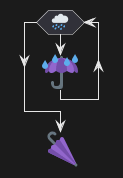La
sintaxis anterior utilizada para los diagramas de actividad presentaba varias limitaciones y problemas de mantenimiento. Reconociendo estos inconvenientes, hemos introducido una sintaxis e implementación totalmente renovadas que no sólo son fáciles de usar, sino también más estables.
Ventajas de la nueva sintaxis
- Sin dependencia de Graphviz: Al igual que con los diagramas de secuencia, la nueva sintaxis elimina la necesidad de instalar Graphviz, simplificando así el proceso de configuración.
- Facilidad de mantenimiento: La * naturaleza intuitiva de la nueva sintaxis significa que es más fácil de manejar y mantener sus diagramas.
Transición a la Nueva Sintaxis
Mientras que continuaremos apoyando la sintaxis antigua para mantener la compatibilidad, animamos a los usuarios a migrar a la nueva sintaxis para aprovechar las características mejoradas y los beneficios que ofrece.
Haga el cambio hoy y experimente un proceso de diagramación más ágil y eficiente con la nueva sintaxis de diagrama de actividad.
Las etiquetas de las actividades inician con un dos puntos (
:) y terminan con un punto y coma (
;).
Se puede aplicar formato a un texto usando
sintaxis de WikiCreole.
Están implícitamente enlazados en el orden de su definición.
|
🎉 Copied!


|
@startuml
:Hello world;
:This is on defined on
several **lines**;
@enduml
|
Simple action list separated by -
|
🎉 Copied!


|
@startuml
- Action 1
- Action 2
- Action 3
@enduml
|
Simple action list separated by *
With one level
|
🎉 Copied!


|
@startuml
* Action 1
* Action 2
* Action 3
@enduml
|
With several levels
|
🎉 Copied!


|
@startuml
<style>
element {MinimumWidth 150}
</style>
* Action 1
** Sub-Action 1.1
** Sub-Action 1.2
*** Sub-Action 1.2.1
*** Sub-Action 1.2.2
* Action 2
@enduml
|
[Ref. GH-2376]
Puede utilizar las palabras clave
start y
stop para indicar el
inicio y el final de un diagrama.
|
🎉 Copied!


|
@startuml
start
:Hello world;
:This is defined on
several **lines**;
stop
@enduml
|
También puede utilizar la palabra clave
end.
|
🎉 Copied!


|
@startuml
start
:Hello world;
:This is defined on
several **lines**;
end
@enduml
|
Puede utilizar las palabras clave
if,
then,
else y
endif para colocar pruebas en su diagrama.
Las etiquetas pueden proporcionarse utilizando paréntesis.
Las 3 sintaxis son posibles:
if (...) then (...) ... [else (...) ...] endif
|
🎉 Copied!


|
@startuml
start
if (Graphviz installed?) then (yes)
:process all\ndiagrams;
else (no)
:process only
__sequence__ and __activity__ diagrams;
endif
stop
@enduml
|
if (...) is (...) then ... [else (...) ...] endif
|
🎉 Copied!


|
@startuml
if (color?) is (<color:red>red) then
:print red;
else
:print not red;
endif
@enduml
|
if (...) equals (...) then ... [else (...) ...] endif
|
🎉 Copied!


|
@startuml
if (counter?) equals (5) then
:print 5;
else
:print not 5;
endif
@enduml
|
[
Ref. QA-301]
Condicionales anidadas (modo horizontal)
Puede utilizar la palabra clave
elseif para tener varias condicionales anidadas
(por defecto, es el modo horizontal):
|
🎉 Copied!


|
@startuml
start
if (condition A) then (yes)
:Text 1;
elseif (condition B) then (yes)
:Text 2;
stop
(no) elseif (condition C) then (yes)
:Text 3;
(no) elseif (condition D) then (yes)
:Text 4;
else (nothing)
:Text else;
endif
stop
@enduml
|
Condicionales anidadas (modo vertical)
Puede utilizar el comando
!pragma useVerticalIf on para tener las condicionales anidadas en modo vertical:
|
🎉 Copied!


|
@startuml
!pragma useVerticalIf on
start
if (condition A) then (yes)
:Text 1;
elseif (condition B) then (yes)
:Text 2;
stop
elseif (condition C) then (yes)
:Text 3;
elseif (condition D) then (yes)
:Text 4;
else (nothing)
:Text else;
endif
stop
@enduml
|
Puede utilizar la opción de
línea de comandos -P para especificar el pragma:
java -jar plantuml.jar -PuseVerticalIf=on
[Refs. QA-3931, GH-582]
WARNING
This translation need to be updated. WARNING
Puedes usar las palabras clave
switch,
case y
endswitch para hacer un switch en tu diagrama.
Puedes colocar etiquetas usando paréntesis.
|
🎉 Copied!


|
@startuml
start
switch (test?)
case ( condition A )
:Text 1;
case ( condition B )
:Text 2;
case ( condition C )
:Text 3;
case ( condition D )
:Text 4;
case ( condition E )
:Text 5;
endswitch
stop
@enduml
|
You can stop action on a if loop.
|
🎉 Copied!


|
@startuml
if (condition?) then
:error;
stop
endif
#palegreen:action;
@enduml
|
But if you want to stop at the precise action, you can use the
kill or
detach keyword:
|
🎉 Copied!


|
@startuml
if (condition?) then
#pink:error;
kill
endif
#palegreen:action;
@enduml
|
[Ref. QA-265]
|
🎉 Copied!


|
@startuml
if (condition?) then
#pink:error;
detach
endif
#palegreen:action;
@enduml
|
Puedes usar las palabras reservadas
repeat y
repeatwhile para colocar bucles.
|
🎉 Copied!


|
@startuml
start
repeat
:read data;
:generate diagrams;
repeat while (more data?)
stop
@enduml
|
It is also possible to use a full action as
repeat target and insert an action in the return path using the
backward keyword.
|
🎉 Copied!


|
@startuml
start
repeat :foo as starting label;
:read data;
:generate diagrams;
backward:This is backward;
repeat while (more data?)
stop
@enduml
|
*[Ref. [QA-5826](https://forum.plantuml.net/5826/please-provide-action-repeat-loop-start-instead-condition?show=5831#a5831)]*
WARNING
This translation need to be updated. WARNING
You can use the
break keyword after an action on a loop.
|
🎉 Copied!


|
@startuml
start
repeat
:Test something;
if (Something went wrong?) then (no)
#palegreen:OK;
break
endif
->NOK;
:Alert "Error with long text";
repeat while (Something went wrong with long text?) is (yes) not (no)
->//merged step//;
:Alert "Success";
stop
@enduml
|
[Ref. QA-6105]
⚠ It is currently only experimental 🚧
You can use
label and
goto keywords to denote goto processing, with:
label <label_name>goto <label_name>
|
🎉 Copied!


|
@startuml
title Point two queries to same activity\nwith `goto`
start
if (Test Question?) then (yes)
'space label only for alignment
label sp_lab0
label sp_lab1
'real label
label lab
:shared;
else (no)
if (Second Test Question?) then (yes)
label sp_lab2
goto sp_lab1
else
:nonShared;
endif
endif
:merge;
@enduml
|
[Ref. QA-15026, QA-12526 and initially QA-1626]
Puedes usar las palabras reservadas
while y
end while para un ciclo repetitivo.
|
🎉 Copied!


|
@startuml
start
while (data available?)
:read data;
:generate diagrams;
endwhile
stop
@enduml
|
Es posible proporcionar una etiqueta después de la palabra reservada
endwhile, o usar la palabra reservada
is .
|
🎉 Copied!


|
@startuml
while (check filesize ?) is (not empty)
:read file;
endwhile (empty)
:close file;
@enduml
|
WARNING
This translation need to be updated. WARNING
Puedes usar las palabras reservadas
fork,
fork again y
end fork para denotar procesamientos paralelos.
|
🎉 Copied!


|
@startuml
start
if (multiprocessor?) then (yes)
fork
:Treatment 1;
fork again
:Treatment 2;
end fork
else (monoproc)
:Treatment 1;
:Treatment 2;
endif
@enduml
|
WARNING
This translation need to be updated. WARNING
Split
You can use
split,
split again and
end split keywords to denote split processing.
|
🎉 Copied!


|
@startuml
start
split
:A;
split again
:B;
split again
:C;
split again
:a;
:b;
end split
:D;
end
@enduml
|
Input split (multi-start)
You can use
hidden arrows to make an input split (multi-start):
|
🎉 Copied!


|
@startuml
split
-[hidden]->
:A;
split again
-[hidden]->
:B;
split again
-[hidden]->
:C;
end split
:D;
@enduml
|
|
🎉 Copied!


|
@startuml
split
-[hidden]->
:A;
split again
-[hidden]->
:a;
:b;
split again
-[hidden]->
(Z)
end split
:D;
@enduml
|
[Ref. QA-8662]
Output split (multi-end)
You can use
kill or
detach to make an output split (multi-end):
|
🎉 Copied!


|
@startuml
start
split
:A;
kill
split again
:B;
detach
split again
:C;
kill
end split
@enduml
|
|
🎉 Copied!


|
@startuml
start
split
:A;
kill
split again
:b;
:c;
detach
split again
(Z)
detach
split again
end
split again
stop
end split
@enduml
|
Se puede aplicar formato a un texto usando
sintaxis de WikiCreole.
Una nota puede ser flotante, usando la palabra clave
floating.
|
🎉 Copied!


|
@startuml
start
:foo1;
floating note left: This is a note
:foo2;
note right
This note is on several
//lines// and can
contain <b>HTML</b>
====
* Calling the method ""foo()"" is prohibited
end note
stop
@enduml
|
*[Ref. [QA-2398](https://forum.plantuml.net/2398/is-it-possible-to-add-a-comment-on-top-of-a-activity-partition?show=2403#a2403)]*
WARNING
This translation need to be updated. WARNING
Puedes especificar
colores en algunas actividades.
|
🎉 Copied!


|
@startuml
start
:starting progress;
#HotPink:reading configuration files
These files should edited at this point!;
#AAAAAA:ending of the process;
@enduml
|
*[Ref. [QA-4906](https://forum.plantuml.net/4906/setting-ad-hoc-gradient-backgrounds-in-activity?show=4917#a4917)]*
WARNING
This translation need to be updated. WARNING
You can use
skinparam ArrowHeadColor none in order to connect activities using lines only, without arrows.
|
🎉 Copied!


|
@startuml
skinparam ArrowHeadColor none
start
:Hello world;
:This is on defined on
several **lines**;
stop
@enduml
|
|
🎉 Copied!


|
@startuml
skinparam ArrowHeadColor none
start
repeat :Enter data;
:Submit;
backward :Warning;
repeat while (Valid?) is (No) not (Yes)
stop
@enduml
|
Usando la notación
->, puedes añadir texto a una flecha y cambiar su
color.
También es posible tener flechas punteadas, en linea discontinua, en negrita u ocultas.
|
🎉 Copied!


|
@startuml
:foo1;
-> You can put text on arrows;
if (test) then
-[#blue]->
:foo2;
-[#green,dashed]-> The text can
also be on several lines
and **very** long...;
:foo3;
else
-[#black,dotted]->
:foo4;
endif
-[#gray,bold]->
:foo5;
@enduml
|
You can use multiple colored arrow.
|
🎉 Copied!


|
@startuml
skinparam colorArrowSeparationSpace 1
start
-[#red;#green;#orange;#blue]->
if(a?)then(yes)
-[#red]->
:activity;
-[#red]->
if(c?)then(yes)
-[#maroon,dashed]->
else(no)
-[#red]->
if(b?)then(yes)
-[#maroon,dashed]->
else(no)
-[#blue,dashed;dotted]->
:do a;
-[#red]->
:do b;
-[#red]->
endif
-[#red;#maroon,dashed]->
endif
-[#red;#maroon,dashed]->
elseif(e?)then(yes)
-[#green]->
if(c?)then(yes)
-[#maroon,dashed]->
else(no)
-[#green]->
if(d?)then(yes)
-[#maroon,dashed]->
else(no)
-[#green]->
:do something; <<continuous>>
-[#green]->
endif
-[#green;#maroon,dashed]->
partition dummy {
:some function;
}
-[#green;#maroon,dashed]->
endif
-[#green;#maroon,dashed]->
elseif(f?)then(yes)
-[#orange]->
:activity; <<continuous>>
-[#orange]->
else(no)
-[#blue,dashed;dotted]->
endif
stop
@enduml
|
[Ref. QA-4411]
You can use parentheses to denote connector.
|
🎉 Copied!


|
@startuml
start
:Some activity;
(A)
detach
(A)
:Other activity;
@enduml
|
You can add
color on connector.
|
🎉 Copied!


|
@startuml
start
:The connector below
wishes he was blue;
#blue:(B)
:This next connector
feels that she would
be better off green;
#green:(G)
stop
@enduml
|
[Ref. QA-10077]
And even use style on Circle:
|
🎉 Copied!


|
@startuml
<style>
circle {
Backgroundcolor palegreen
LineColor green
LineThickness 2
}
</style>
(1)
:a;
(A)
@enduml
|
[Ref. QA-19975]
Puedes agrupar actividades definiendo particiones:
|
🎉 Copied!


|
@startuml
start
partition Initialization {
:read config file;
:init internal variable;
}
partition Running {
:wait for user interaction;
:print information;
}
stop
@enduml
|
*[Ref. [QA-2793](https://forum.plantuml.net/2793/activity-beta-partition-name-more-than-one-word-does-not-work?show=2798#a2798)]*
*[Ref. [QA-542](https://forum.plantuml.net/542/ability-to-define-hyperlink-on-diagram-elements?show=14003#c14003)]*
WARNING
This translation need to be updated. WARNING
Usando la tecla pipe
|, puedes definir carriles.
También es posible cambiar el
color de los carriles.
|
🎉 Copied!


|
@startuml
|Swimlane1|
start
:foo1;
|#AntiqueWhite|Swimlane2|
:foo2;
:foo3;
|Swimlane1|
:foo4;
|Swimlane2|
:foo5;
stop
@enduml
|
*[Ref. [QA-2681](https://forum.plantuml.net/2681/possible-define-alias-swimlane-place-alias-everywhere-else?show=2685#a2685)]*
WARNING
This translation need to be updated. WARNING
Es posible remover una flecha usando la palabra reservada
detach .
|
🎉 Copied!


|
@startuml
:start;
fork
:foo1;
:foo2;
fork again
:foo3;
detach
endfork
if (foo4) then
:foo5;
detach
endif
:foo6;
detach
:foo7;
stop
@enduml
|
Cambiando el sepador final,
; , puedes configurar diferentes representaciones para una actividad:
|
🎉 Copied!


|
@startuml
:Ready;
:next(o)|
:Receiving;
split
:nak(i)<
:ack(o)>
split again
:ack(i)<
:next(o)
on several line|
:i := i + 1]
:ack(o)>
split again
:err(i)<
:nak(o)>
split again
:foo/
split again
:i > 5}
stop
end split
:finish;
@enduml
|
WARNING
This translation need to be updated. WARNING
Table of UML Shape Name
|
Name
|
Stereotype syntax
|
|
ObjectNode
|
<<object>>
|
ObjectNode
typed by signal
|
<<objectSignal>> or <<object-signal>>
|
AcceptEventAction
without TimeEvent trigger
|
<<acceptEvent>> or <<accept-event>>
|
AcceptEventAction
with TimeEvent trigger
|
<<timeEvent>> or <<time-event>>
|
SendSignalAction
SendObjectAction
with signal type
|
<<sendSignal>> or <<send-signal>>
|
|
Trigger
|
<<trigger>>
|
[Ref. GH-2185]
UML Shape Example using Stereotype
|
🎉 Copied!


|
@startuml
:action;
:object; <<object>>
:ObjectNode
typed by signal; <<objectSignal>>
:AcceptEventAction
without TimeEvent trigger; <<acceptEvent>>
:SendSignalAction; <<sendSignal>>
:SendObjectAction
with signal type; <<sendSignal>>
:Trigger; <<trigger>>
:\t\t\t\t\t\tAcceptEventAction
\t\t\t\t\t\twith TimeEvent trigger; <<timeEvent>>
:an action;
@enduml
|
[Ref. GH-2185, QA-16558, GH-1659]
|
🎉 Copied!


|
@startuml
start
:ClickServlet.handleRequest();
:new page;
if (Page.onSecurityCheck) then (true)
:Page.onInit();
if (isForward?) then (no)
:Process controls;
if (continue processing?) then (no)
stop
endif
if (isPost?) then (yes)
:Page.onPost();
else (no)
:Page.onGet();
endif
:Page.onRender();
endif
else (false)
endif
if (do redirect?) then (yes)
:redirect process;
else
if (do forward?) then (yes)
:Forward request;
else (no)
:Render page template;
endif
endif
stop
@enduml
|
Inside style (by default)
|
🎉 Copied!


|
@startuml
skinparam conditionStyle inside
start
repeat
:act1;
:act2;
repeatwhile (<b>end)
:act3;
@enduml
|
|
🎉 Copied!


|
@startuml
start
repeat
:act1;
:act2;
repeatwhile (<b>end)
:act3;
@enduml
|
Diamond style
|
🎉 Copied!


|
@startuml
skinparam conditionStyle diamond
start
repeat
:act1;
:act2;
repeatwhile (<b>end)
:act3;
@enduml
|
InsideDiamond (or Foo1) style
|
🎉 Copied!


|
@startuml
skinparam conditionStyle InsideDiamond
start
repeat
:act1;
:act2;
repeatwhile (<b>end)
:act3;
@enduml
|
|
🎉 Copied!


|
@startuml
skinparam conditionStyle foo1
start
repeat
:act1;
:act2;
repeatwhile (<b>end)
:act3;
@enduml
|
[Ref. QA-1290 and #400]
Diamond style (by default)
|
🎉 Copied!


|
@startuml
skinparam ConditionEndStyle diamond
:A;
if (decision) then (yes)
:B1;
else (no)
endif
:C;
@enduml
|
- With two branches (
B1, B2)
|
🎉 Copied!


|
@startuml
skinparam ConditionEndStyle diamond
:A;
if (decision) then (yes)
:B1;
else (no)
:B2;
endif
:C;
@enduml
@enduml
|
Horizontal line (hline) style
|
🎉 Copied!


|
@startuml
skinparam ConditionEndStyle hline
:A;
if (decision) then (yes)
:B1;
else (no)
endif
:C;
@enduml
|
- With two branches (
B1, B2)
|
🎉 Copied!


|
@startuml
skinparam ConditionEndStyle hline
:A;
if (decision) then (yes)
:B1;
else (no)
:B2;
endif
:C;
@enduml
@enduml
|
[Ref. QA-4015]
Without style (by default)
|
🎉 Copied!


|
@startuml
start
:init;
-> test of color;
if (color?) is (<color:red>red) then
:print red;
else
:print not red;
note right: no color
endif
partition End {
:end;
}
-> this is the end;
end
@enduml
|
With style
You can use
style to change rendering of elements.
|
🎉 Copied!


|
@startuml
<style>
activityDiagram {
BackgroundColor #33668E
BorderColor #33668E
FontColor #888
FontName arial
diamond {
BackgroundColor #ccf
LineColor #00FF00
FontColor green
FontName arial
FontSize 15
}
arrow {
FontColor gold
FontName arial
FontSize 15
}
partition {
LineColor red
FontColor green
RoundCorner 10
BackgroundColor PeachPuff
}
note {
FontColor Blue
LineColor Navy
BackgroundColor #ccf
}
}
document {
BackgroundColor transparent
}
</style>
start
:init;
-> test of color;
if (color?) is (<color:red>red) then
:print red;
else
:print not red;
note right: no color
endif
partition End {
:end;
}
-> this is the end;
end
@enduml
|
You can use
emoji as action, with the stereotype
<<icon>>:
|
🎉 Copied!


|
@startuml
while (<:cloud_with_rain:>)
:<:umbrella:>; <<icon>>
endwhile
-<<icon>><:closed_umbrella:>
@enduml
|
[Ref. GH-2436]
